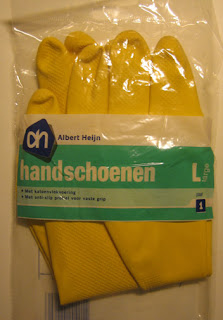This is going to be a photo-centered post about bicycles. I'd read about Holland and Denmark having a lot of bicycles, but I had not seen images that convinced me this was the case. I'm going to show some infrastructure and pictures to convince you about the pervasiveness of bicycles in Holland. But first I'm going to go over a standard Dutch bicycle.
I bought a bicycle last weekend:



My bicycle is a standard Dutch bicycle. There are a few things you'll notice are different than an American bicycle. First of all, there is the luggage rack over the rear tire. All standard bicycles in Holland have these racks. When I say standard, I mean bicycles which aren't racing or folding bicycles. Second, the handlebars are curved. Very few bicycles have straight handlebars. I'd guess it is a style thing, though I'm saying this simply because I understand neither style nor curved handlebars so I'm lumping the two together. The lock is also a bit different, as the next three photos show. The first photo is a picture of the left side - there is a key that cannot be removed unless you turn the metal bar on the right side. The bar goes into the back wheel. You can see the bar in second and third photos below.



Next to my bicycle this morning was another type of Dutch bicycle:

While buying my bike, I asked the store clerk about why some bikes have the curved metal like this one. He said it is a girl's model (I swear I've seen guys riding bikes like these). He didn't have a good reason was it is a girl's model, but it does look more stylish than a standard bicycle.
As I wrote in my post on my apartment, the building has bicycle sheds. Here is a photo of one floor's bicycle shed:

There is also a general area for parking bicycles in the apartment building:

My workplace actually has an underground bicycle parking lot! Rijwielingang, the sign over the entrace, literally means "row wheel entrance". Rijwiel, or "row wheel", is one of the three common Dutch words for a bicycle - the other two are fiets and tweewieler. "Ingang" means entrance. Google Translate only bats about .750 with Dutch.


To give you an idea of how common bicycle commuting is, here are some other "parking lots". The first picture was taken outside my building at about 5 pm. Parking underground is a bit of a hassle, as you have to pedal up the tunnel - a lot of people park outside and risk the rain. The second shot was taken at the library (bibliotheek). The third shot shows one of five or six parking lots near the train station.



Finally, to give you an idea of the infrastructure I've been talking about, I took a picture of the bicycle "light" at an intersection. You can see that bicycles, like cars, have to wait at a stoplight when crossing an intersection. There is a push button for requesting a crossing. The bicycle request button has a feedback light, but the pedestrian button does not.

As for roads, you can see above that bicycles have separate roads from the cars. Most bicycle paths are next to the street, as you can see in the first two photos below. There are lots of bicycle-only paths, like the third photo.



The next photo is a bit difficult to describe. Due to the train traffic, few streets cross the train tracks, most go under or over. There is a big tunnel that goes under the train tracks near the town center. There are two separate tunnels for bicyclists and moped riders on the outside, and two tunnels of two lanes for cars and motorcyclists in the middle of the bridge. The sign with a red circle on the border of a car and a motorcycle signifies that cars and motorcycles are not to use the outside path.

If you are wondering about scooters, my experience is that scooters are considered a type of moped. I believe there are six classes of traffic on the road: trucks, cars, motorcycles, scooters/mopeds, bicycle, and pedestrians. I've seen a motorcycle or two take a path valid for scooters/mopeds, but I'm pretty sure this is illegal.
While I was "driving" home from work yesterday,
Abtswoudsebrug had to let a boat through. The bridge is only for pedestrians and bicyclists, and it was a bit of a traffic jam.


The second photo above shows a common type of bag placed across the luggage rack of a bicycle.
If you want to see more about the types of bicycles, I suggest
this post. The author has a lot of pictures of types of bicycles, and talks about the things that surprise foreigners (buitenlanders). First, helmets are the exception, rather than the rule. Policemen and children wear helmets, but no one else. Second, formally dressed individuals ride bicycles, even women in skirts. A girl will sometimes wear a skirt over tight black pants, I'm assuming the pants protect against the cold and make riding a bicycle less awkward. Third, it is common for a second person to ride on the luggage rack. Guys will "ride luggage" (I made that up) with other guys, too, though this is less common.
The only type of bicycle the other post missed mentioning is the folding bicycle. I didn't get a good shot of one, as these bicycles are less common. You see a folded bicycle every now and then on the train. One can bring a non-folding bicycle onto roughly half of the trains, though this requires a special ticket. Folding bicycles are allowed onto all the trains at no extra charge.
I hope you enjoyed the set of photos discussing bicycles in Delft. I'll post updates if I ever find a folding bicycle.

















































